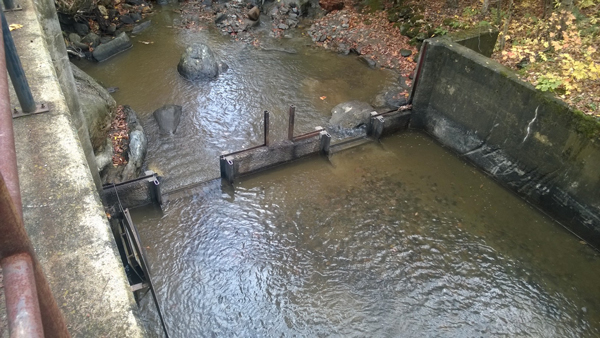Skiers and fish are an unlikely pairing, but they both have one more reason to be excited this fall – an important piece of snowmaking infrastructure is now fish-friendly.
Thanks to a partnership between Sugarbush Resort and a team of local, state and federal partners, Sugarbush’s snowmaking weir (basically a small dam to collect water for making snow) in Slide Brook across from Fayston Elementary School now allows trout to move upstream and gives them access to 2.4 miles of additional habitat.
“One of Sugarbush’s core values is being a responsible member of our community. The Mad River Valley is a special place, and we believe it is our responsibility to preserve and improve our wonderful natural surroundings while building a viable and sustainable business,” said Win Smith, president of Sugarbush Resort.
The weir will continue its snowmaking function during the winter months, while its new windows will allow for fish and sediment movement during the spring, summer and fall seasons.
“This modification benefits the economy and the ecosystem; skiers can feel assured that Sugarbush is acting as a good steward of the Mad River Valley’s important natural resources and the fish benefit from additional cold-water habitat that is especially important as they adapt to a changing climate,” said Corrie Miller, executive director of Friends of the Mad River (FMR). FMR worked on the project with the Winooski Natural Resources Conservation District.
Additionally, the weir’s new windows also allow sediment movement downstream to more closely mimic the natural system, which may prove to require less maintenance work for Sugarbush and less damaging erosion and sedimentation (filled with excessive nutrients) downstream.
Since Tropical Storm Irene, FMR has coordinated with municipal, private, state and federal partners to increase stream connectivity, improve wildlife habitat and build the community’s flood resilience by repairing infrastructure that negatively impacts the river system.
“As part of this initiative, partners identified Sugarbush Resort’s weir as problematic from both fish habitat and long-term maintenance perspectives. With these challenges in mind and Sugarbush’s commitment to be involved, this site rose to the top of our watershed’s priorities for replacement,” Miller added.
“It is inspiring to see the collaborative work conducted between the public sector, watershed groups and state and federal agencies for the protection of our natural resources,” said Corrina Parnapy, district manager of Winooski Natural Resources Conservation District.
The three-year-long effort – through the planning, engineering, permitting and construction phases – culminated last week when the windows were cut into the Slide Brook weir.
Friends of the Mad River, U.S. Fish and Wildlife Service, U.S. Forest Service, Vermont Department of Fish and Wildlife, Winooski Natural Resources Conservation District and Sugarbush Resort joined forces to accomplish the project with funding from Sugarbush Resort, a Vermont watershed grant, a state wildlife grant as well as cooperative agreements with federal partners.
Thanks to Grover Engineering, Kingsbury Construction and Canonica Farm and Forest Services for their dedicated work in support of this effort.
“Seeing Sugarbush’s commitment to careful stewardship of our natural resources reminds me how special the Mad River Valley is. Here, we all understand that the health of the ecosystem is the foundation of our community vitality and our quality of life,” Miller added.
For more information about Mad River Valley efforts to build flood resilience and aquatic organism passage, contact Friends of the Mad River. For more information about this project, visit www.friendsofthemadriver.org, www.winooskinrcd.org or www.sugarbush.com.







